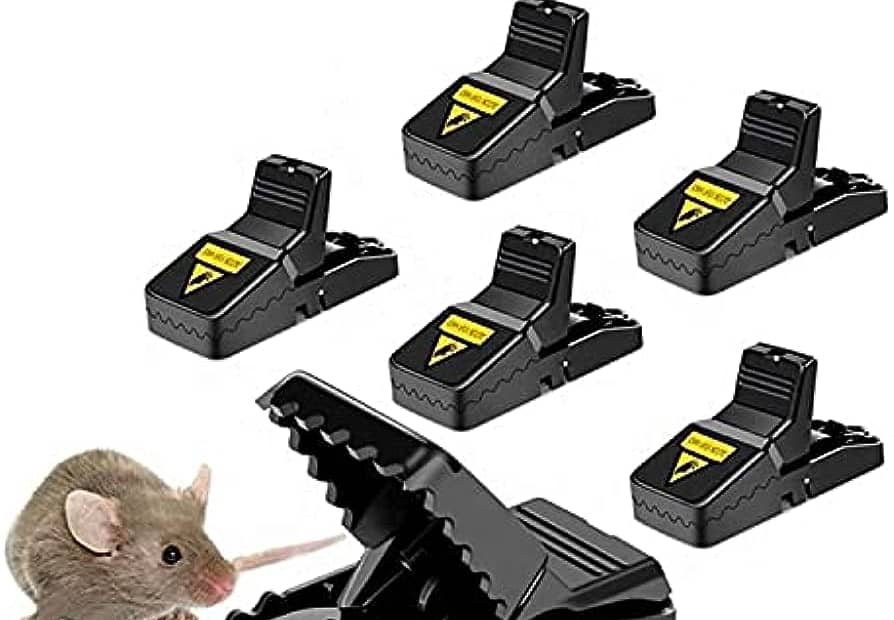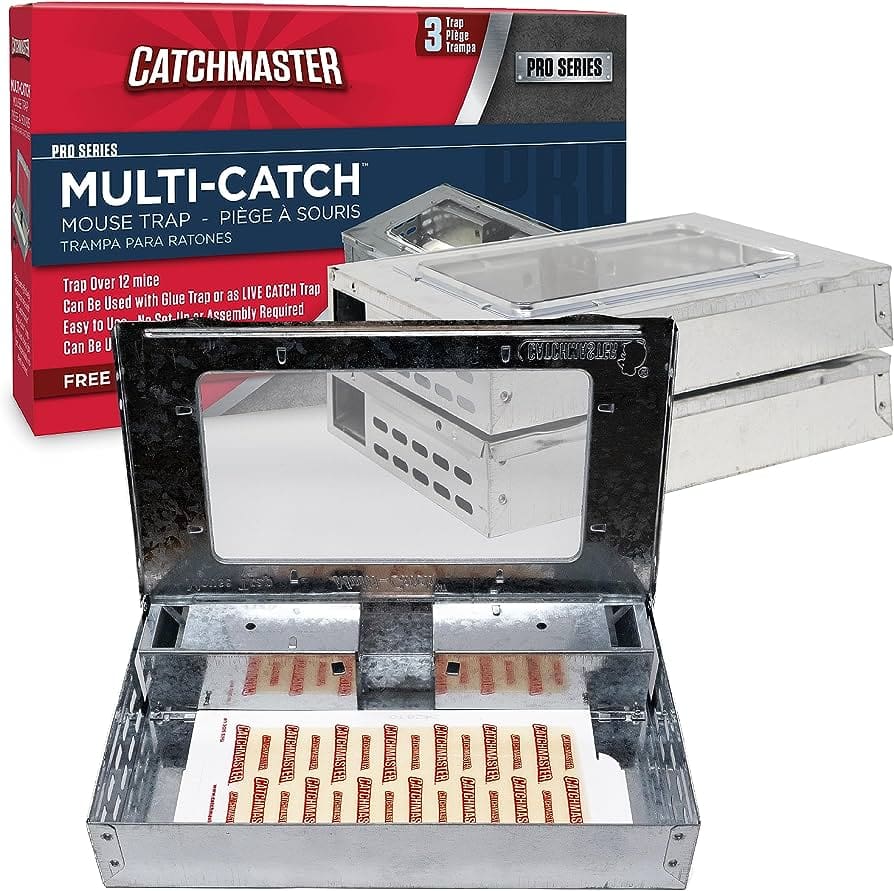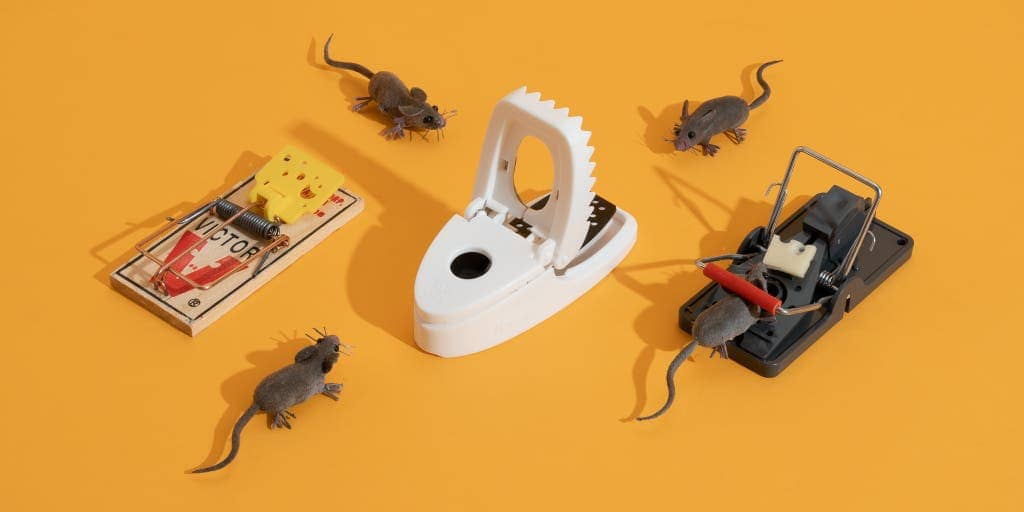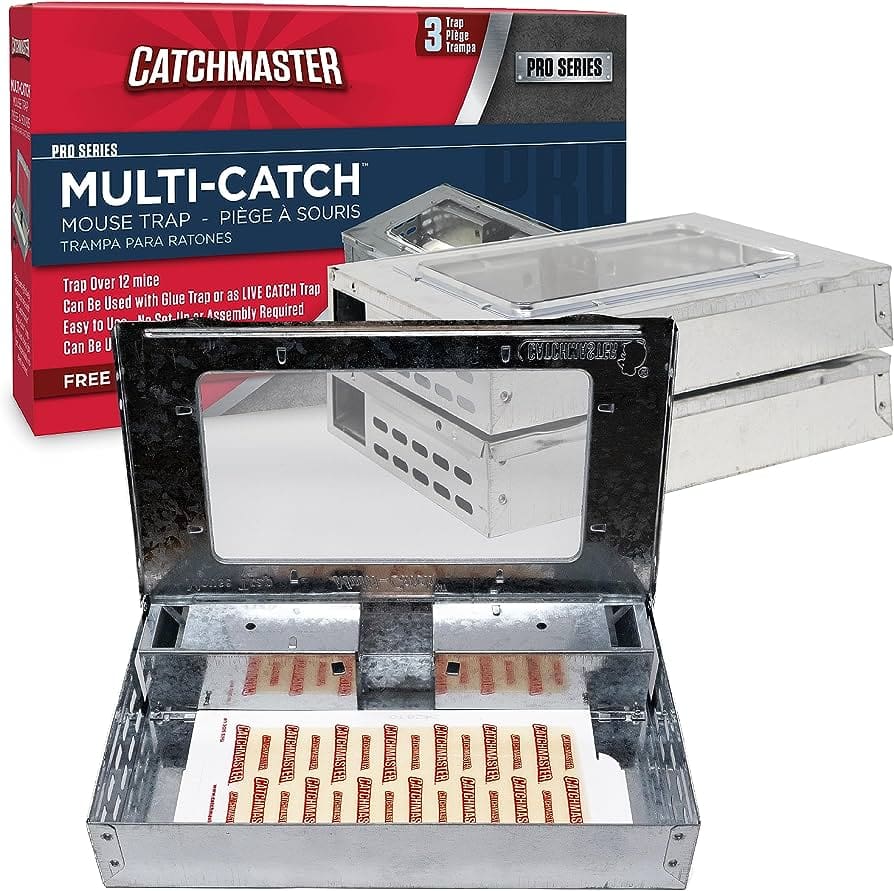Mouse traps are safe for home use as long as they are used properly. When used correctly, mouse traps are an effective and humane method to control the mouse population in your home.
Pest control experts recommend using snap traps or catch-and-release traps to avoid harm to both humans and mice. By following the instructions and placing the traps in appropriate locations, you can eliminate the presence of mice without posing a risk to your household.
It is important to regularly check the traps and dispose of any caught mice to maintain a clean and pest-free environment. Remember to use caution and handle the traps with care to prevent any accidents or injuries.
Understanding The Various Types Of Mouse Traps
Mouse traps come in various types, each with its own safety considerations for home use. Learn about the different options available to effectively and safely get rid of mice in your house.
Snap Traps: Classic And Effective
Snap traps have been a go-to mouse control method for decades, thanks to their simplicity and effectiveness. These traditional traps consist of a wooden or plastic base with a spring-loaded metal bar that snaps shut when triggered by the mouse.
Here are some key points about snap traps:
- Quick and efficient: Snap traps react swiftly, providing an almost instantaneous solution to your mouse problem.
- Cost-effective: Snap traps are affordable and readily available, making them a budget-friendly option for homeowners.
- Easy to use: Setting up snap traps is straightforward – simply bait the trigger mechanism and place the trap in strategic areas.
- Humane killing: While snap traps are lethal to mice, they are considered a humane method as they provide a quick death.
Electronic Traps: Innovative And Efficient
With advancements in technology, electronic traps have emerged as an innovative and efficient alternative to traditional snap traps. These traps are designed to electrocute mice upon contact, providing a humane and reliable solution. Here’s what you need to know about electronic traps:
- High success rate: Electronic traps boast a high success rate, ensuring that mice are effectively eliminated from your home.
- Easy to set up: Most electronic traps are straightforward to assemble and use, making them user-friendly even for those who are new to pest control.
- Safe for pets and children: Unlike some other types of traps, electronic traps are designed with safety mechanisms to prevent accidental harm to pets and children.
- Quick disposal: Electronic traps typically provide an indicator light or sound to alert you when a mouse has been caught, making disposal quick and effortless.
Glue Traps: Controversial And Inhumane
While glue traps may be an option for trapping mice, they are a highly controversial method due to their inhumane nature. Glue traps consist of a sticky adhesive surface that ensnares mice upon contact. Here are some important aspects to consider about glue traps:
- Prolonged suffering: Glue traps subject mice to prolonged suffering, as they are unable to escape and may die from exhaustion, dehydration, or injuries sustained while trying to free themselves.
- Potential for non-target captures: Unfortunately, glue traps are not selective and may inadvertently trap non-target animals, such as birds or lizards.
- Difficult removal: Removing a live mouse from a glue trap can be challenging and may cause further harm to the trapped animal.
- Ethical concerns: Due to the inhumane nature of glue traps, many individuals and organizations advocate for their discontinuation in favor of more humane alternatives.
Understanding the various types of mouse traps is crucial in deciding which method aligns with your preferences and ethical considerations. While snap traps offer a classic and effective solution, electronic traps provide an innovative approach with added convenience. However, it is essential to consider the controversial and inhumane nature of glue traps before opting for this method.
Choose a mouse trap that suits your needs while ensuring the humane treatment of rodents.
Evaluating The Safety Factors Of Mouse Traps
Mouse traps are commonly used in homes to eliminate rodents, but it is essential to evaluate their safety factors. Before using mouse traps, consider their design and potential risks to ensure a safe environment for both humans and pets.
Mouse traps are commonly used to control mouse infestations in homes. While they can be effective in eliminating mice, it is important to consider the safety aspects associated with their use. This article will explore the potential hazards that mouse traps pose to pets and children, the risks of accidental injuries to humans, and the ethical considerations and animal welfare implications of using mouse traps.
Potential Hazards For Pets And Children
Using mouse traps in homes where pets and children are present requires careful consideration. Here are some potential hazards to keep in mind:
- Pet injuries: Pets, particularly cats and small dogs, may get injured if they come into contact with a mouse trap. The snapping action of traditional spring traps can cause harm to their paws, noses, or tails.
- Poison exposures: Some mouse traps use poison baits to lure mice. These baits pose a significant risk to pets and children if ingested. Ingestion can lead to serious health issues and even fatalities.
- Trap entrapment: Curious children or pets may accidentally trigger the mouse trap if they get their fingers, paws, or tails caught. This can cause injury or trauma.
Risks Of Accidental Injuries To Humans
While mouse traps are intended to target mice, there is still a potential risk of accidental injuries for humans. Here are some key points to consider:
- Finger injuries: When setting or releasing mouse traps, there is a risk of finger injuries if not handled properly. The spring-loaded traps can snap shut unexpectedly, leading to pinched or injured fingers.
- Tripping hazards: Mouse traps placed in areas with high human traffic can pose a tripping hazard. If someone inadvertently steps on a mouse trap, they may lose balance and fall, potentially resulting in injuries.
- Allergic reactions: In certain cases, individuals with allergies or sensitivities to mouse allergens may experience discomfort or respiratory issues when coming in contact with mouse traps or the remains of trapped mice.
Ethical Considerations And Animal Welfare
Using mouse traps raises ethical questions concerning animal welfare. While the primary aim is to control mice populations, it is crucial to consider the humane treatment of these animals. Here are some ethical considerations:
- Humane trapping methods: Some mouse trap options prioritize humane trapping and release, allowing for the capture of mice without causing harm. These traps enable their safe relocation to outdoor areas away from homes.
- Quick and humane kill methods: For traps that involve killing mice, quick and humane methods are essential to minimize suffering. Properly designed traps can ensure swift and ethical elimination of trapped mice.
- Respect for animal life: Regardless of the chosen trapping method, it is important to treat trapped mice with respect and dispose of them appropriately. This includes avoiding prolonged suffering and using proper disposal methods that comply with local regulations.
While mouse traps can be effective in controlling mouse infestations, understanding the safety factors associated with their use is crucial. Considering the potential hazards for pets and children, the risks of accidental injuries to humans, and the ethical implications towards animal welfare helps ensure the responsible and safe use of mouse traps in homes.
Comparing The Effectiveness And Humaneness Of Mouse Traps
Mouse traps are a common solution for eliminating pests at home, but concerns arise regarding their effectiveness and humaneness. Discover the safety of using mouse traps as we compare their impact on both pest control and the well-being of these tiny creatures.
Are Mouse Traps Safe For Home Use?
Are you experiencing a mouse problem in your home? If so, you may be considering using mouse traps to address the issue. However, before diving into this option, it’s important to understand the effectiveness and humaneness of these traps, as well as their impact on non-target species and the environment.
In this section, we will explore these factors to help you make an informed decision about using mouse traps in your home.
Efficiency In Catching And Killing Mice
When it comes to mouse traps, efficiency is key. Here are some points to consider in terms of their effectiveness in catching and killing mice:
- Snap traps: These traditional traps are quick and lethal. They consist of a spring-loaded mechanism that snaps shut when triggered by the mouse. The advantages of snap traps include their high success rate in catching and killing mice swiftly and effectively.
- Glue traps: Glue traps are adhesive surfaces that capture mice when they walk onto them. Although they are not designed to kill mice immediately, they can be lethal if the trapped mouse struggles and becomes exhausted. Glue traps are an option for those who prefer a non-lethal approach.
- Electronic traps: These traps use an electric current to deliver a lethal shock to the mouse. They are quick, efficient, and minimize the risk of the mouse escaping or suffering unnecessarily.
Assessing The Impact On Non-Target Species
While mouse traps are designed to target mice specifically, it is important to consider their potential impact on non-target species. Here are some factors to keep in mind:
- Placement: Proper trap placement is crucial to minimize the chances of unintended captures. Placing traps in areas where non-target animal access is limited, such as inside cabinets or behind appliances, can reduce the likelihood of unintended harm.
- Size of traps: Choosing traps that are specifically designed for mice can help reduce the risk of accidentally capturing larger animals, such as squirrels or birds.
- Monitoring: Regularly checking traps allows for the safe release of non-target animals. If a non-target species is accidentally captured, it is important to release it promptly and safely, ensuring minimal stress and harm.
Examining The Environmental Consequences
Considering the environmental consequences of using mouse traps is essential for maintaining a sustainable and eco-friendly approach. Here are a few environmental factors to consider:
- Disposal: When disposing of captured mice, it is essential to follow local regulations and guidelines. Avoid releasing them into the wild, as this can disrupt ecosystems. Instead, opt for humane disposal methods or consult local authorities for advice.
- Avoiding harmful substances: Some rodenticides and chemicals used in mouse traps can have adverse effects on the environment. Opt for traps that do not rely on toxic substances, minimizing the risk of contamination.
- Prevention and alternative approaches: Implementing preventive measures, such as sealing entry points and practicing proper sanitation, can reduce the need for mouse traps altogether. Additionally, exploring alternative methods like ultrasonic devices or natural repellents may provide viable alternatives.
By considering the efficiency, impact on non-target species, and environmental consequences of mouse traps, you can make an informed decision about their use in your home. Remember to prioritize the safety and well-being of all creatures involved, creating a harmonious living environment for both humans and animals.
The Role Of Snap Traps In Mouse Control
Snap traps play a crucial role in mouse control and are safe to use in homes. These traps effectively catch mice, ensuring a pest-free environment without any harm to humans or pets.
Snap traps, one of the most common types of mouse traps, play a vital role in effectively controlling mouse infestations. While there are other options available in the market, snap traps remain a popular choice due to their efficiency and affordability.
In this section, we will explore the pros and cons of traditional snap traps, the dangers of mishandling them, and how to minimize risks for safe usage.
Traditional Snap Traps: Pros And Cons
- Quick and effective: Snap traps are known for their ability to swiftly catch and kill mice, making them a reliable option for homeowners.
- Affordable: These traps are widely accessible and come at a budget-friendly price, allowing anyone to address mice problems without breaking the bank.
- Non-toxic: Unlike certain chemical-based alternatives, snap traps do not pose a risk to human health or the environment.
The Dangers Of Mishandling Snap Traps
- Accidental injuries: Mishandling snap traps can lead to painful injuries, such as fingers getting caught in the trap’s mechanism. It is crucial to exercise caution and follow proper procedures to avoid any harm.
- Pet and child safety: Snap traps can also pose a risk to curious pets or children who might accidentally trigger them. Taking necessary precautions is essential when using these traps in households with pets or young children.
Minimizing Risks And Ensuring Safe Usage
To ensure safe usage of snap traps while effectively controlling mouse infestations, consider the following tips:
- Placement: Position snap traps in areas where mouse activity is observed, such as along walls, near entrances, or in crawl spaces.
- Protecting non-targeted individuals: Use protective covers designed specifically for snap traps to prevent accidental triggering and protect pets or children from harm.
- Regular monitoring: Check the traps regularly and dispose of any captured mice promptly. This helps maintain trap efficiency and prevents potential health hazards from decomposing rodents.
- Proper disposal: Handle and dispose of captured mice in a hygienic manner, wearing gloves and avoiding direct contact. Seal mouse carcasses in a plastic bag and dispose of them in accordance with local regulations.
When used correctly, snap traps can be a safe and effective method for mouse control in homes. By carefully considering the pros and cons, avoiding mishandling, and minimizing risks, homeowners can confidently utilize snap traps as part of their pest control strategy.
Remember, always prioritize safety and follow the manufacturer’s instructions to achieve the best results in mouse control.
Exploring The Controversy Surrounding Glue Traps
Glue traps have sparked controversy due to concerns about their safety for home use. Many question whether these mouse traps are humane and effective, prompting discussions about alternative methods.
Are Mouse Traps Safe For Home Use?
Mice infestations can be a frustrating and unhygienic problem in any home. When it comes to finding a solution, many homeowners turn to mouse traps. These devices are designed to catch and eliminate mice, but the various types of traps available can spark a debate about safety and ethics.
In this blog post, we will explore the controversy surrounding glue traps, one of the frequently used methods for trapping mice in homes.
Understanding How Glue Traps Work:
- Glue traps are flat surfaces coated with a sticky adhesive, designed to trap mice.
- When a mouse steps onto the trap, it becomes stuck to the adhesive, making it unable to escape.
- Glue traps are often placed along walls, near areas where mouse activity is suspected.
Ethical Concerns And Animal Cruelty:
- Critics argue that glue traps are inhumane because they cause immense suffering to trapped mice.
- Once stuck, mice can struggle for hours or even days, often resulting in injury or death from exhaustion, dehydration, or starvation.
- Many people find this method cruel and believe there are more compassionate alternatives.
Alternative And More Humane Solutions:
- Snap traps: These traps are designed to kill mice instantly, minimizing suffering compared to glue traps. However, they still raise ethical concerns for some.
- Live traps: These traps capture mice without harming them, allowing for their release into designated outdoor areas or with the help of pest control professionals. This is a popular choice for those seeking a humane resolution.
- Ultrasonic devices: Emitting high-frequency sound waves that only mice can hear, these devices aim to deter rodents from entering your home without causing them physical harm. While they may not work for every situation, they can be effective in some cases.
The use of glue traps for dealing with mice infestations is a topic of controversy due to ethical concerns and animal cruelty. While they are one method of capturing mice, many argue that there are alternative and more humane solutions available.
Ultimately, the choice of trap or method used should be based on individual beliefs and considerations for both the well-being of mice and the household.
The Rise Of Electronic Traps And Their Safety Considerations
Electronic traps are gaining popularity as an alternative to traditional mouse traps. However, safety considerations should be taken into account before using them at home.
The use of traditional mouse traps has long been a popular method for dealing with household rodent problems. However, with advancing technology and increasing concerns about safety and efficiency, electronic traps have gained traction as an alternative. In this section, we will explore how electronic traps function, discuss their advantages and disadvantages, and address safety concerns and proper usage.
How Electronic Traps Function
Electronic traps are designed to efficiently capture and eliminate rodents using innovative technology. Here’s an overview of how these traps work:
- Electric shock: Electronic traps deliver a high-voltage electric shock to instantly eliminate mice or rats that enter the trap. This method ensures quick and humane extermination.
- Detection system: These traps employ advanced sensors to detect the presence of a rodent. Once triggered, the trap activates and delivers the lethal shock to the rodent.
- Bait attraction: To entice mice or rats into the trap, electronic models often feature a compartment for placing bait, such as peanut butter or dry pet food. The enticing smell draws the rodents towards the trap.
Advantages And Disadvantages Of Electronic Traps
Before considering the use of electronic traps, it’s essential to weigh their advantages and disadvantages. Here are the key points to consider:
Advantages:
- Efficiency: Electronic traps deliver quick and effective results, eliminating rodents in a matter of seconds.
- Humane approach: Compared to traditional traps, electronic traps provide a more humane method of extermination, minimizing suffering for the rodents.
- Reusability: Many electronic traps can be reused, making them cost-effective in the long run.
Disadvantages:
- Power source dependence: Electronic traps require a power source, typically batteries, which need to be replaced periodically. This may add to the ongoing cost of using these traps.
- Limited capacity: Some electronic traps can only capture one rodent at a time. If you have a severe infestation, multiple traps may be necessary.
- Sensitivity to environmental conditions: Extreme weather conditions, such as excessive heat or cold, can impact the functionality of electronic traps. Consider the climate in your area before choosing this option.
Addressing Safety Concerns And Proper Usage
While electronic traps provide an efficient and humane approach to rodent control, it’s important to use them safely and effectively. Consider the following guidelines for safe and proper usage:
- Keep out of reach: Place electronic traps in areas where children and pets cannot access them to prevent any potential accidents.
- Regular maintenance: Check the traps regularly to ensure they are in good working condition. Clean them thoroughly after each use to maintain proper hygiene.
- Follow manufacturer instructions: Each electronic trap may have specific instructions for bait placement and usage. Adhere to these guidelines to maximize the trap’s effectiveness.
- Placement considerations: Position traps along rodent runways or near entry points, such as gaps in walls or doors, to increase the likelihood of capturing mice or rats.
Electronic traps offer an efficient and humane solution for dealing with rodents in your home. Understanding how they function, their advantages and disadvantages, and implementing proper safety measures will help you make an informed decision and use them effectively.
Tips For Safe And Effective Use Of Mouse Traps
Mouse traps can be safe and effective for home use if used correctly. Follow these tips for a safe trap set-up: place traps in areas inaccessible to children and pets, use bait that is non-toxic and attractive to mice, and regularly check and dispose of trapped mice to maintain a clean environment.
Mouse traps can be a highly effective solution for dealing with unwelcome critters in our homes. However, it’s essential to use them safely and efficiently to ensure both your safety and the humane treatment of the mice. Here are some tips to help you make the most of your mouse trap:
Placement And Positioning For Maximum Effectiveness
- Identify areas with mouse activity: Start by identifying areas where you have noticed signs of mouse activity, such as droppings or chewed wires. These are the best places to position your traps.
- Place traps along walls and entry points: Mice tend to follow the edges of walls, so placing traps perpendicular to the walls ensures they will come into contact with the traps more easily.
- Set traps in multiple locations: For larger infestations, it’s important to set traps in multiple locations to increase your chances of success. Place traps strategically in areas with the most evidence of mouse activity.
- Avoid cluttered areas: Ensure that the trap has enough space to function properly. Avoid placing traps in cluttered areas where objects could interfere with the trap mechanism.
Securing Traps To Prevent Accidental Activation
- Secure traps to avoid unintended activation: To prevent accidental activation, consider securing the traps in place. You can use adhesive or double-sided tape to keep them in position, making it more difficult for mice to drag the traps away without setting them off.
- Anchor traps with heavy objects: For added stability, anchor the traps with heavy objects such as books or bricks. This prevents the traps from being moved by curious pets or unintended disturbances, ensuring their effectiveness.
Regular Inspection And Disposal Of Captured Mice
- Check traps frequently: Regularly inspect your traps to ensure any captured mice are promptly dealt with. Regular checks not only prevent mice from suffering longer than necessary but also improve the overall effectiveness of your trapping efforts.
- Use gloves while handling traps: When disposing of captured mice, it’s important to wear gloves to protect yourself from any potential diseases. Place the trapped mouse into a plastic bag and seal it tightly before disposing of it in an appropriate manner.
- Clean traps after each use: After disposing of a caught mouse, it’s vital to clean the trap thoroughly to remove any remaining odor. Mice can detect the presence of their species, so a clean trap will improve the chances of catching more mice.
Remember, the proper placement, secure positioning, and regular inspection of mouse traps are crucial for their safety and effectiveness. By following these tips, you can create an environment that efficiently tackles unwanted mouse intruders. Stay vigilant and act promptly to keep your home mouse-free.
Alternative Methods For Mouse Prevention And Control
Discover safe and effective alternatives to traditional mouse traps to prevent and control mouse infestations in your home. Explore a range of methods that are humane, eco-friendly, and highly effective in keeping your living space rodent-free.
Mouse infestations can be a nuisance and a potential health hazard in our homes. While mouse traps are a common method for controlling these pests, you may be wondering if there are alternative methods that are safe for home use.
In this section, we will explore a few alternative approaches that can help prevent and control mouse infestations without the use of traditional traps.
Sealing Entry Points And Denying Access:
- Identify and seal any gaps or holes in the foundation, walls, and around windows and doors using caulk or steel wool. Mice can squeeze through very small openings, so be thorough in your inspection.
- Install weatherstripping on doors and windows to prevent mice from gaining entry.
- Use door sweeps on exterior doors to create a barrier against mice.
- Ensure that your vents, chimneys, and any other openings are properly covered with mesh or screens to prevent mouse entry.
- Keep your garage door closed at all times and seal any gaps or cracks in the garage walls.
- Trim tree branches and shrubs near your home that may act as bridges for mice to access your property.
Proper Food Storage And Waste Management:
- Store all food in airtight containers, including dry goods such as cereal, rice, and flour. Mice are attracted to food sources, so eliminating their access to it is crucial.
- Clean up spills and crumbs immediately to remove potential food sources for mice.
- Dispose of garbage regularly and ensure that your trash cans have tight-fitting lids.
- Avoid leaving pet food out overnight as it can attract mice. Store pet food in sealed containers.
- Keep bird feeders away from your home, as spilled seeds can attract mice.
Natural Deterrents And Repellents:
- Peppermint oil: Soak cotton balls with peppermint oil and place them in areas where mice are likely to be. Mice are repelled by the strong scent of peppermint.
- Mothballs: Place mothballs in closets, attics, and other mouse-prone areas. The strong smell deters mice from entering.
- Ultrasonic repellents: These devices emit high-frequency sound waves that are unpleasant to mice but inaudible to humans. Place them in rooms where mice are commonly found.
- Remove clutter: Mice are more likely to nest in areas with clutter. Keeping your home tidy and organized can help deter them.
By implementing these alternative methods, you can take proactive steps to prevent mouse infestations and control existing ones without relying solely on mouse traps. Remember to be consistent and thorough in your approach to keep those pesky critters at bay.

Credit: www.homedepot.com
Frequently Asked Questions On Are Mouse Traps Safe For Home Use?
Are Mouse Traps Safe For Humans?
Yes, mouse traps are safe for humans as long as they are used correctly.
What Are The Disadvantages Of Mouse Traps?
Mouse traps have a few downsides. They can harm or kill the mouse, and sometimes they are not effective enough.
Where Should Mouse Traps Be Placed In The House?
Place mouse traps in areas where mice are frequently seen, such as near food sources or along walls.
What Is The Safest Way To Set A Mouse Trap?
To set a mouse trap safely, follow these steps: 1. Choose a trap with a secure design. 2. Place the trap in areas frequented by mice, like along walls. 3. Use gloves and bait the trap with peanut butter or cheese.
4. Set the trap carefully, ensuring the spring is properly engaged.
Conclusion
Are mouse traps safe for home use? The safety of using mouse traps in your home is a valid concern for many homeowners. While traditional snap traps are effective at catching mice, they can also pose risks to children and pets.
However, there are several safe alternatives available on the market. Electronic mouse traps are one option. These traps use a high-voltage shock to instantly kill mice, eliminating the risk of them escaping and potentially spreading diseases. Another safe option is the use of catch-and-release traps, which allow you to capture the mice alive and then release them outside.
These traps are humane and eliminate the risk of accidental injury to pets and children. Ultimately, it is crucial to weigh the effectiveness and safety of different mouse trap options to make an informed decision for your home. Remember to consider the needs of your household and choose the best option that ensures both safety and peace of mind.




